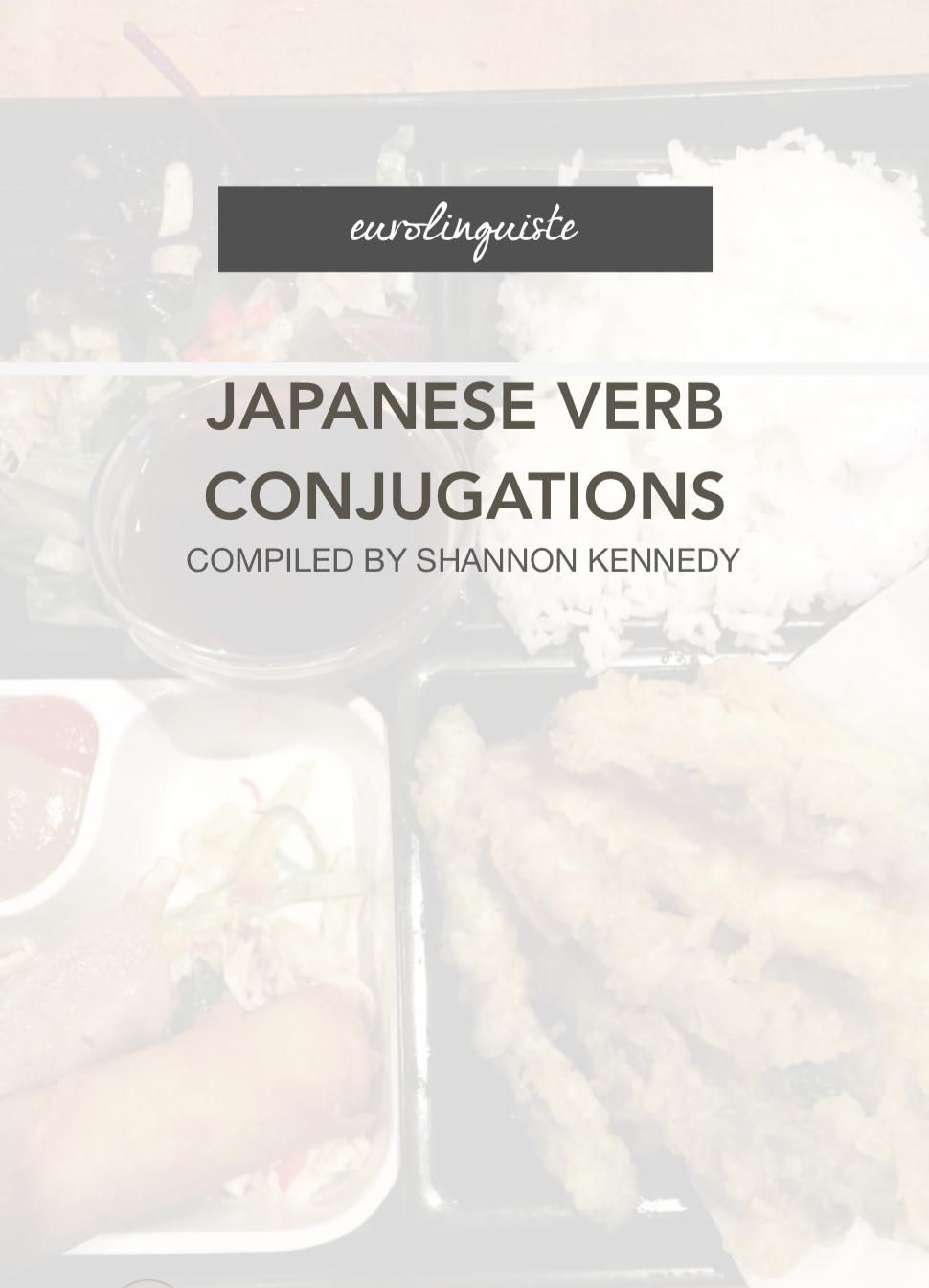JAPANESE VERB FORMS | HOW TO CONJUGATE VERBS IN JAPANESE

My name is Shannon Kennedy and I'm the language lover,…
When we think of verb conjugation, we often think of it from a European language perspective. We run through the verb conjugation tables we learned in school – I run, you run, he runs, she runs, we run, they run…
But Japanese doesn’t handle verbs in quite the same way.
Rather than needing to figure out how to conjugate verbs based on who is doing the action, you conjugate them based on who you’re addressing (formal/informal) and the action that’s taking place.
This was something that I struggled with, and I juggled tons of different versions of verbs in my head, never sure when or where to use them. So I started to collect the different forms. This guide is the result.
In it, I share how to conjugate the three different verb forms, plus you can download my PDF resource with several of the most used verbs and a wide range of their different conjugations both for formal and informal address. I hope that you find it useful.
Get your free PDF with 10+ Japanese Verb Conjugations

Conjugating Japanese Verbs
Japanese conjugation is the same regardless of the subject. You don’t need to worry about learning “I read, you read, she reads” because the form of the verb will be the same regardless of who is doing the action.
You do, however, conjugate verbs based on who you’re addressing and the context of the action taking place. For example, take a look at how the following verbs differ when addressing someone in a formal situation (~masu form) versus an informal situation (plain form).
Here are a few factors that may modify the verb form:
- Formality // There are three levels of formality, or keigo, in Japanese (sonkei-go, kenjo-go, teinei-go). Each changes the way you use verbs.
- Yes or no // Positive and negative sentences have different conjugations.
- Tense // If you’re talking about something in the present or future, you’ll use a different verb form than if you’re talking about something that happened in the past.
- Action // If you are in the process of doing something, it will take a different form than if you’re talking about it more generally. This may sound difficult, but we have this in English. For example, it’s the difference between “I study” and “I’m studying”.
| Formal Japanese | Informal Japanese | English |
| します | する | to do |
| いきます | いく | to go |
| たべます | たべる | to eat |
Japanese verbs are grouped into three different types: ~u verbs, ~iru and ~eru verbs, and irregular verbs. They have several different forms including:
- ~masu form
- plain form
- dictionary form
- ~te form
- ~i form
- conditional
- potential
- imperative
- volitional
- etc.
Japanese verbs have two parts, the suffix and the stem. Splitting these components apart and modifying them is how you conjugate a verb. Take みる (to look) for example. み or 見 (kanji) is the stem while is る the base.
Conjugating みる
| Form | Japanese | Transliteration |
| ~masu (polite) | みます | mimasu |
| plain | みる | miru |
| ~masu negative | みません | mimasen |
| plain form negative | みない | minai |
How the Three Verb Forms Differ
Japanese verbs are placed into three groups because they are each modified a little differently.
~Ru Verbs
To conjugate a ~ru verb, you replace ~ru with the appropriate ending as done in the the above example “to look”. This group is often also called the ~eru and ~iru verb group because almost all ~eru and ~iru verbs are ~ru verbs and not ~u verbs.
~U Verbs
This is the more complex of the Japanese verb groups because despite the ending being ~u, the word can actually end in ~ku, ~su, ~tsu, ~nu, and even… ~ru. Some notable exceptions where a ~ru ending is actually a ~u verb include kaeru (to return), hairu (to enter), shiru (to know) and iru (to need).
Irregular Verbs
Japanese only has two irregular verbs (hooray!) kuru (to come) and suru (to do). They are both common verbs, but suru is one that you’ll use often. Particularly because it combines with other words to form additional verbs – take benkyou suru (to study) for instance.
Using Conjugations to Express Different Actions
With Japanese conjugation, you can attach a variety of endings to express a lot of different ideas. It’s a very useful technique to use because you memorize the endings and tack them on to the ends of different verbs to immediately construct more complex sentences. Here are just a few using みる as an example.
| Ending | Japanese | English (formal forms) |
| ~mashita | みました | I saw |
| ~tsumoridesu | みるつもりです | I plan to see |
| ~nakerebanaranaidesu | みなければならないです | I must see |
| ~taidesu | みたいです | I want to see |
| ~nikuidesu | みにくいです | It’s hard to see |
A Cheat Sheet for Japanese Verb Conjugation
My Japanese tutor and I worked together to assemble 32 different verb conjugations or form for more than ten of the most common Japanese verbs. I regularly reference it in my studies, so I thought it would be a useful resource for many other Japanese learners.
Verb conjugation can be tricky, especially when you need to memorize tons of different rules and forms. Having a reference point is a great way to get started and wrap your head around more complex grammar and information.

Are you learning Japanese? What are some phrases that you’ve found useful in your target language? I’d love to hear about them in the comments!
What's Your Reaction?
My name is Shannon Kennedy and I'm the language lover, traveler, and foodie behind Eurolinguiste. I'm also the Resident Polyglot at Drops and the Head Coach of the Fluent in 3 Months Challenge.



